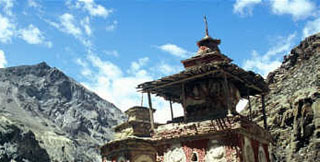Trekking - Annapurna - Narphu Valley Trek
Narphu Valley Trek (26 Days)
Trip Facts
Trekking Type: Camping Trek
Trekking Grade: ▲▲▲ (?)
Maximum Altitude: 5416 m.
Best Season: October - November, March - May
 Hidden by swirls of mountain mist ahead of us, from Kangla pass at 5200m the magnificent panorama view of Annapurna massif appears remote and forbidding.
Hidden by swirls of mountain mist ahead of us, from Kangla pass at 5200m the magnificent panorama view of Annapurna massif appears remote and forbidding.
Our sturdy mountain ponies every few steps, their steaming sweat-soaked bodies heaving. Behind us Hongde airport, which we left behind early in the morning, is a tiny speck. Our destination is the Nar-Phu valley, above the tree line on the upper limits of cultivation, in the very north of Manang district. It takes five hours reaching the pass that links Nar with Manang and three other Bhotia village in the Nyershang down valley.
Nowadays, Nar Phu the population about 300 inhabitants who depend on livestock, unlike most Bhotia people, whose trading patterns changed drastically after the Nepali Government closed borders with Tibet, the people of Nar and Phu valley were least affected by this change. The tortuous path leading from the valley into Tibet had never made them dependent on the salt trade, and till toDay yak herding is the basis of their livelihood.
Besides the Kangla linking Nar to the Nyeshang valley , the most direct route from Kathmandu to Nar and Phu is along the Marshyangdi River. Travellers trek through the Himalayan foothills and round the eastern end of the Annapurna before they arrive at Qupar, a police check post half and hour before Chame, Manang's district headquarters. From here a long and steep trail winds up to Nar and Phu whose villagers, laden with goods purchased in Chame and even lower down in Besishhar, the end of the roadhead leading to Manang, often camp at Dharmashala, a rudimentary wooden hut built by the people from the two villages.
The Nepal government's recent decision to open up Nar and Phu to tourists has evoked little enthusiasm among the villagers, whose pastoral lifestyle continues. Apart from the odd researcher and climbing expeditions permitted to climb Him lung, Ratnachuli and Gachikang, few foreigners has visited the area and tourism infrastructure is almost non-existent. Since Annapurna Conservation Area Project (ACAP) recently extended its network to include Nar and Phu Valley, it is preparing a suitable tourism development plan at the request of the government for undiscovered valley.
Trekking Itinerary
Day 01: Arrival Kathmandu, transfer hotel
Day 02: Kathmandu free Day, hotel
Day 03: Bus to Besisahar, Trek Begins: camp
Day 04: Ngati, camp
Day 05: Jagat, camp
Day 06: Karte, camp
Day 07: Koto, camp
Day 08: Chhacha, camp
Day 09: Meta, camp
Day 10: Junum, camp
Day 11: Phu, camp
Day 12: Rest Day at Phu, camp
Day 13: Hike around Phu valley, camp
Day 14: Yak Kharka, camp
Day 15: Panggi Pass, camp
Day 16: Above Nar, camp
Day 17: Youingar, camp
Day 18: Kangla Pass, camp
Day 19: Manang, camp
Day 20: Khangsar Khola, camp
Day 21: Tilicho Lake, camp
Day 22: Mesokanto Pass, camp
Day 23: Jomsom, camp
Day 24: Flight Jomsom - Pokhara - Kathmandu, transfer to hotel
Day 25: Kathmandu free Day, hotel
Day 26: Final departure, transfer airport



